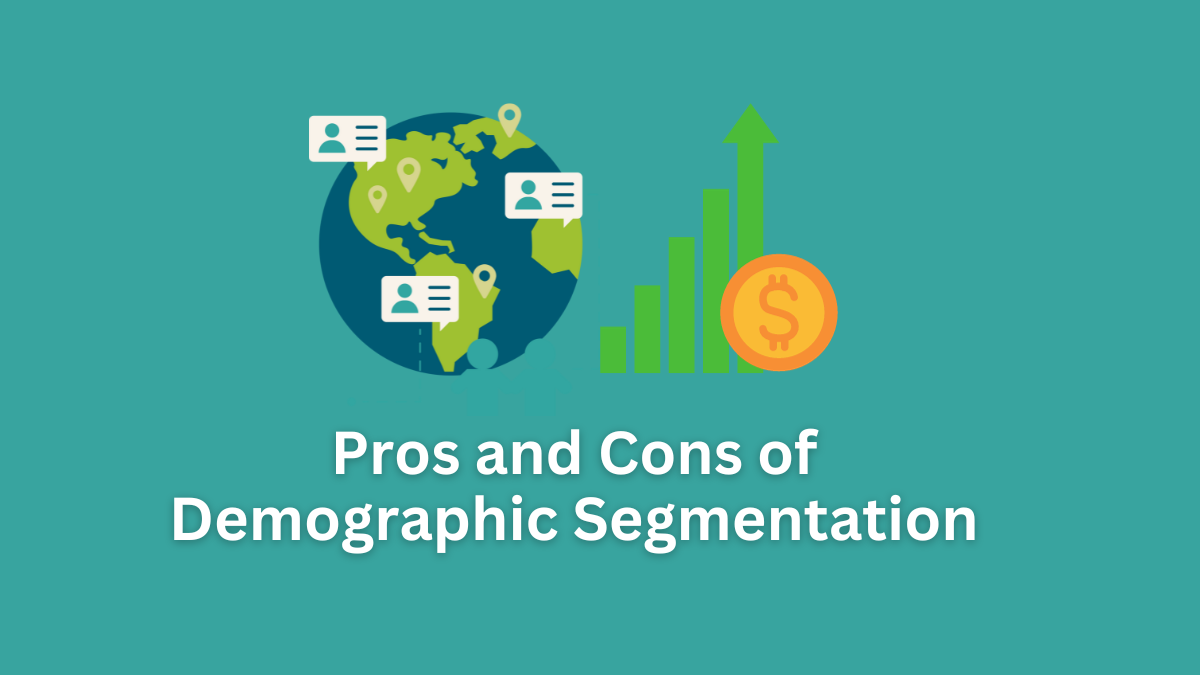Pros and Cons of Demographic Segmentation
Demographic segmentation is a market segmentation strategy where the market is divided based on different demographic factors such as age, gender, ethnicity, education, income, and more.
In this article, we will explore the key pros and cons of demographic segmentation. Let’s get started:
Pros of Demographic Segmentation
Demographic segmentation offers numerous advantages for businesses, helping them understand and connect with their target audience more effectively. Here are eight pros of demographic segmentation mentioned in simple terms:
Detailed Targeting
Demographic segmentation allows you to pinpoint your ideal customers with accuracy. By focusing on specific traits like age, gender, or income, you can tailor your marketing efforts to reach those most likely to buy your products or services.
Read More: Geographic Segmentation – Definition
Personalized Communication
When you know who your audience is, you can speak their language. Demographic segmentation enables personalized marketing messages that resonate with each group’s unique characteristics. It’s like having a one-on-one conversation instead of shouting at a crowd.
Efficient Resource Allocation
Instead of spreading your marketing budget thinly across a broad audience, demographic segmentation helps you allocate resources wisely. You can invest where it matters most, optimizing your marketing spend for maximum impact. Think of it as using a magnifying glass to focus the sun’s rays on a specific spot, creating intense heat.
Better Product Development
Understanding the preferences and needs of different demographic groups guides product development. You can create offerings that cater to specific tastes, ensuring higher customer satisfaction. It’s similar to designing a puzzle piece that fits perfectly into a larger picture.
Read More: 8 Pros and 8 Cons of Geographic Segmentation
Enhanced Customer Satisfaction
Demographic segmentation enables you to offer products or services that align with what each group values most. Satisfied customers are more likely to return, fostering brand loyalty. It’s like finding the perfect pair of shoes that are comfortable, stylish, and just your size – you’d come back for more.
Increased Customer Retention
When you identify and target your customers accurately through demographic segmentation, you’re more likely to satisfy their needs. Satisfied customers are not only more likely to return but also to become loyal advocates for your brand, spreading the word to others.
Adaptation to Market Changes
Demographic data is not static; it evolves with time. Monitoring changes in demographics helps your business adapt to shifting consumer preferences and behaviors.
Read More: 10 Examples of Geographic Segmentation
Competitive Advantage
Companies that effectively use demographic segmentation gain a competitive edge. They can outperform rivals by delivering precisely what their target audience wants. It’s like having the right tool for the job while others struggle with a one-size-fits-all approach.
Cons of Demographic Segmentation
Demographic segmentation indeed offers several benefits for businesses, but it’s essential to consider its limitations and drawbacks as well. Here are seven cons of demographic market segmentation:
Oversimplification
Demographic segmentation assumes that people with similar demographic traits share the same preferences and behaviors. In reality, individual choices can be far more complex. It’s like assuming everyone who wears glasses likes the same type of books.
Read More: Differentiated Vs. Undifferentiated Marketing
Stereotyping
Relying solely on demographics can lead to reinforcing stereotypes. For instance, assuming that all young adults are tech-savvy or that all elderly people are technophobes is overly simplistic. It’s like judging a book by its cover and missing the real story inside.
Ignoring Psychographics
Demographic segmentation doesn’t consider psychographic factors like values, attitudes, and lifestyles, which can significantly influence consumer behavior. It’s like painting a person’s portrait using only their basic physical features and missing their personality.
Constant Change
People’s behaviors and preferences are not static; they evolve over time. Relying on outdated demographic data can lead to misinformed marketing strategies. It’s like using an old map to navigate a rapidly changing landscape.
Read More: Individual Marketing – Definition, Features, Examples
Exclusion of Small Segments
It may overlook smaller customer segments with unique preferences. While targeting the largest segments may be cost-effective, neglecting smaller but potentially profitable groups can be a missed opportunity.
Limited Cultural Sensitivity
Demographic segmentation may not adequately address cultural nuances and diversity. Marketing messages that work for one group may not resonate with another, potentially leading to cultural insensitivity.
Overlooking Individuality
Individuals within a demographic group can have highly varied tastes and behaviors. Relying solely on demographics can overlook these individual differences. It’s like assuming all apples in the same basket are identical, ignoring the subtle variations in flavor and texture.
Read Next: What is Niche Market? Definition, 15 Examples
Arti Kushmi holds a BBS (Bachelor in Business Studies) degree and shares her business and marketing knowledge through this website. While not writing she will be reading and enjoying the moment.
